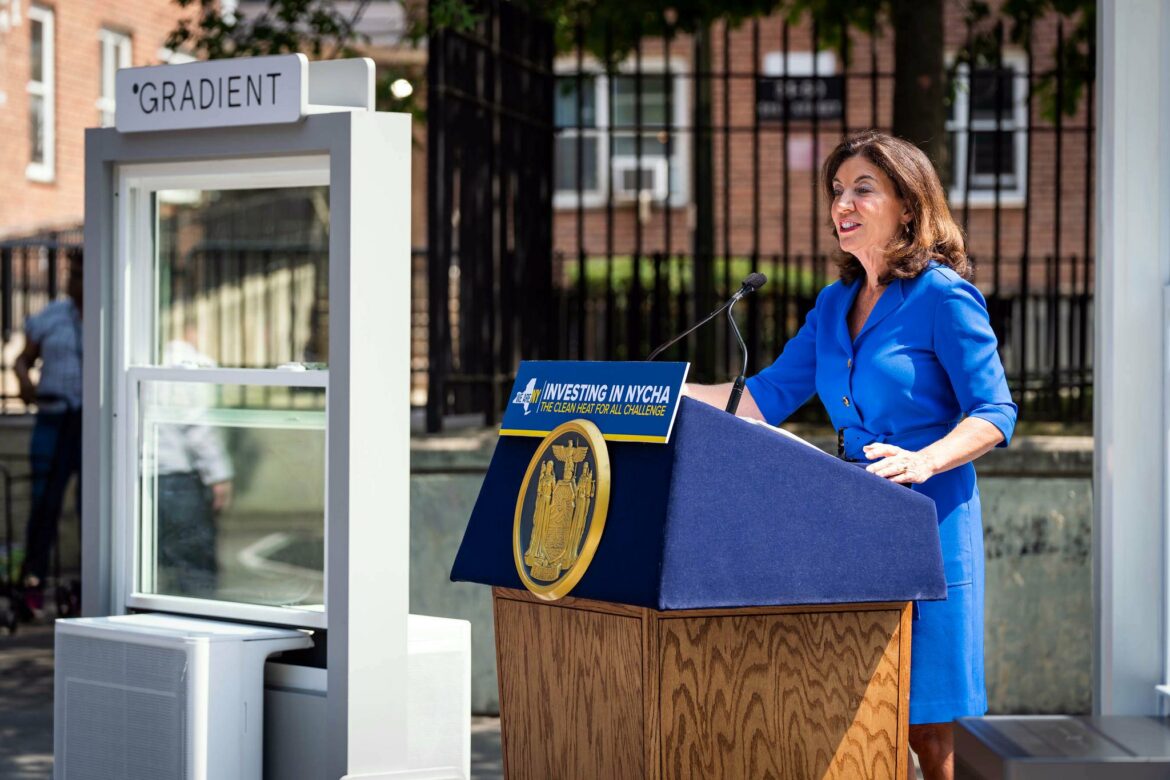New York joined eight other states in an agreement to ensure heat pumps make up 65 percent of residential heating and cooling equipment sales by 2030. The technology is a green alternative to traditional systems that run on fossil fuels and contribute to global warming.

Ed Reed/Mayoral Photography Office
Gov. Kathy Hochul announcing the installation of 30,000 heat pumps in NYCHA buildings in 2022.New York and eight other states signed a formal agreement Wednesday to ensure heat pumps make up 65 percent of statewide residential heating, cooling and water heating equipment sales by 2030—and 90 percent by 2040.
Heat pumps are an environmentally friendly alternative to traditional heating and cooling systems that run on fossil fuels and contribute to global warming. By installing more of them, environmentalists hope buildings will contribute less to climate change. In the Big Apple alone, 70 percent of the city’s greenhouse gas emissions come from buildings.
The agreement, known as a Memorandum of Understanding (MOU), was launched by Northeast States for Coordinated Air Use Management (NESCAUM), an association of state agencies that tackles air pollution and climate change.
The MOU’s goal is to encourage manufacturers to put more heat pumps on the market.
“It’s helpful for the manufacturers to hear from states that this is the direction we’re going. This is how we see the market shifting and we need this transition to happen to meet our climate and energy goals,” Emily Levin, senior policy advisor at NESCAUM, told City Limits.
“And in turn that will give manufacturers confidence to invest in new manufacturing and expand their lines of technologies. So hopefully it creates a kind of positive virtuous cycle,” she added.
The announcement builds on a commitment Gov. Kathy Hochul made five months ago to quadruple heat pump installations across New York by 2030.
“This new MOU places additional focus on developing markets for heat pumps by working with other market players like manufacturers and business leaders,” said Vanessa Ulmer, policy development program manager at the New York State Energy Research and Development Authority (NYSERDA).
“And it creates another way to track the state’s progress,” she explained.
By signing the agreement, New York and other participating states— like California, Oregon and Maine—commit to crafting an action plan within a year to support the goal of amping up heat pump installations, and to track their progress.
The states will also encourage manufacturers and distributors to share data on shipments and sales of heat pump equipment so they can better understand how markets are developing.
National heat pump sales overtook gas furnaces for the first time in 2022, and outpaced gas furnace sales by 26 percent in the first three quarters of 2023, according to market reports analyzed by NESCAUM.
The advantages of using heat pumps are many, experts say. One study found that they are twice as efficient as fossil fuel heating systems in cold climates, which means they waste less energy—and that in turn drives down energy bills.
They also pollute a lot less. Across the memorandum’s nine participating states, fossil-fueled heating equipment emits over 138,000 tons of a polluting gas mixture called nitrogen oxides (NOx) and 6,000 tons of fine particulate matter, the MOU claims. These emissions can lead to increased risk of heart attack, asthma and premature death.
Buildings across participating states also emit 173 million metric tons of CO2, one of the main drivers of global warming.
But heat pumps are still not the norm when it comes to heating and cooling homes, partially because not enough contractors and consumers are familiar with the technology.
“These are also still pretty expensive products,” John Taylor, senior vice president of public affairs at appliance manufacturer LG, told City Limits. “But as the volume of products available on the market increases, they will become more affordable.”
Taylor said LG started investing in heat pump technologies 15 years ago. The electronics giant now has more than 175 heat pump-enabled products for sale in the U.S.
“If you step way back, and you look at our nation’s climate goals and the world’s climate goals, this one particular technology can really move the needle to help achieve greenhouse gas reduction targets,” Taylor said.
“But the government can’t do it on its own and the industry can’t do it on its own. There’s a lot of work to be done and it has to be a collaborative effort. It’s going to take a village, as they say, to make it a success,” he added.
To reach the reporter behind this story, contact Emma@citylimits.flywheelstaging.com. To reach the editor, contact Jeanmarie@citylimits.flywheelstaging.com








